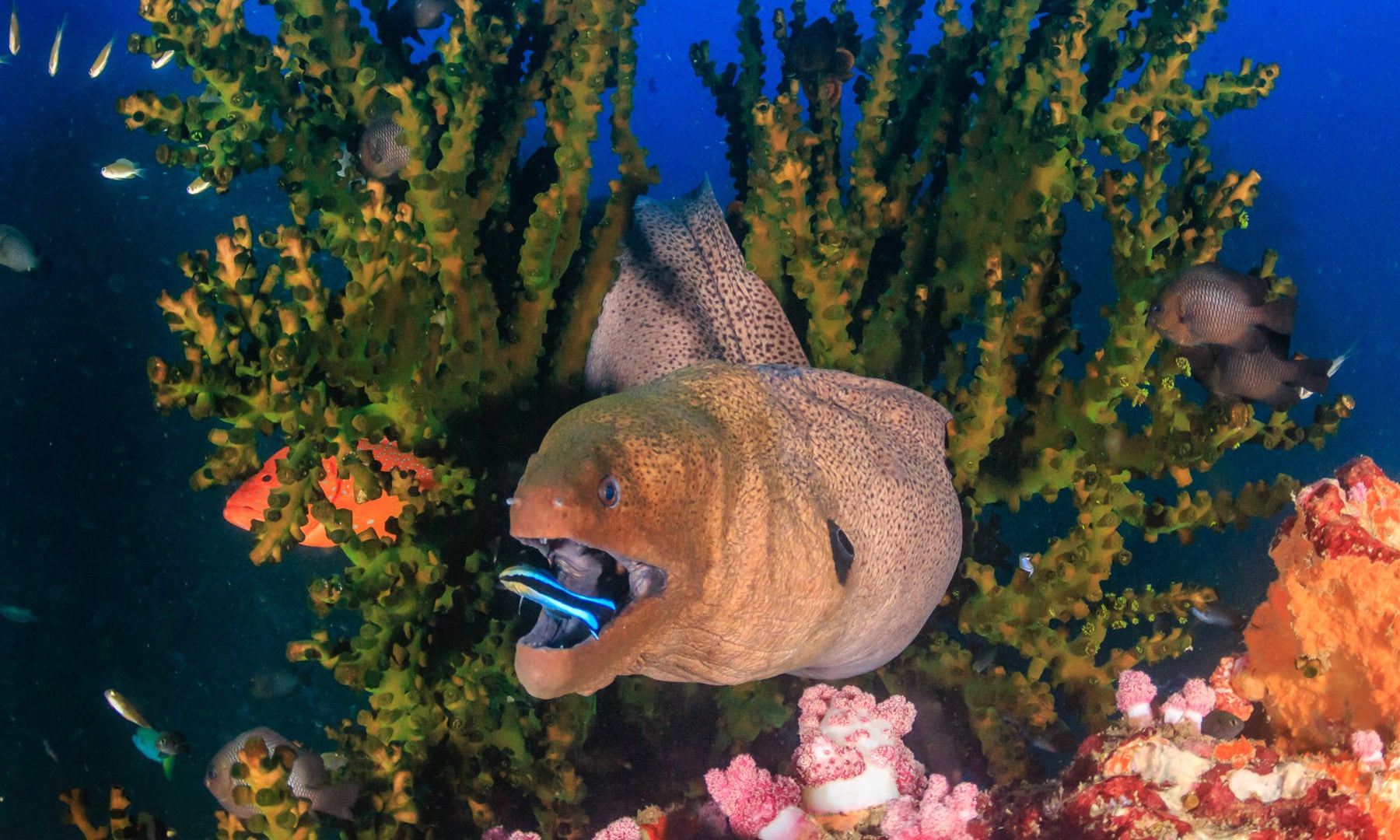There’s a myth that the memory of a goldfish lasts only three seconds. But that wasn’t how Professor Culum Brown saw it when he was 12. He kept fish as pets and would while away the hours staring at them instead of doing his homework. The more he stared, the more they fascinated him. What he found most intriguing was the way they seemed to recognise and react to him.
“They ignored everybody else and they knew that in the morning when I came to feed them I’d put the food in a particular spot and they’d be there waiting,” he says. “It was pretty obvious to me, even as a kid, that they were much smarter than people thought.”
Culum went on to snorkel a lot during his youth in Southeast Asia, where his father worked, and is now a marine biologist at Macquarie University, Sydney. “Most people are oblivious to what goes on in the water,” he says. “The more I looked into it, the more I realised nobody knew much about it. That was a kind of inspiration. I never set out to be a marine biologist, but that’s where life took me.”
For some 20 years now, his focus has been on fish intelligence and cognition. With numerous journal
articles and a major book on the topic, he’s considered Australia’s leading expert. “There was never any doubt in my mind that fish are clever. It was just a question of how clever,” Culum says. “I guess I’m still answering that question.”
The evolution of fish
All vertebrate animals, including fish and humans, descended from a common ancestor. The former belong to a numerous and successful group that originated more than 500 million years ago. First came jawless fish, then cartilaginous fish – sharks, rays, sawfish and skates – about 450 million years ago, followed about 375 million years ago by bony fish, with hard skeletons. This long evolutionary history has given fish ample time to develop complex and diverse behaviours as well as the cognitive hardware to go with them.
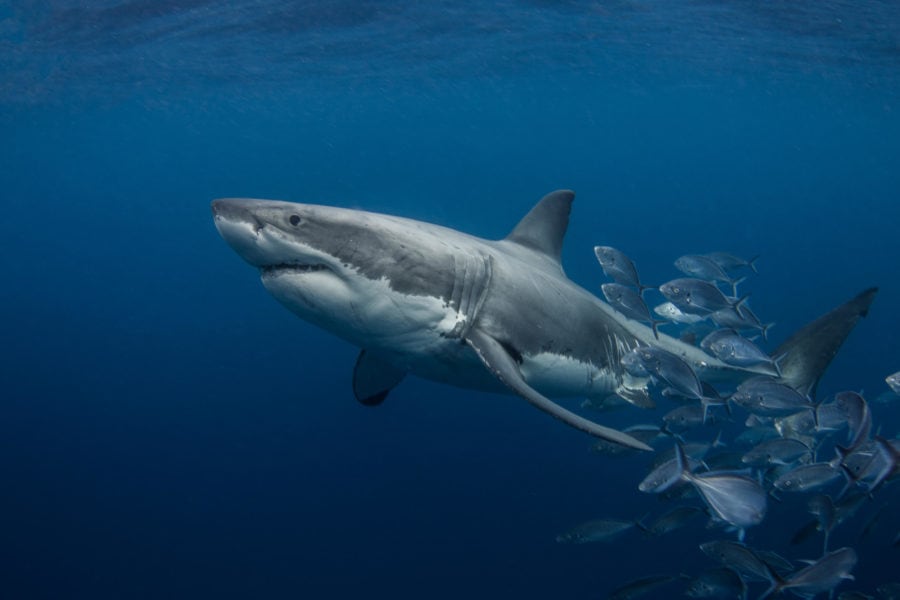
To put that vast span of time into perspective, compare it with the considerably shorter history of the human species, which emerged in its modern form only 195,000 years ago. Because, however, we share ancestors with modern fish, we have many of the same features, Culum says. “Fundamentally, all vertebrates have been built from the same box of Lego,” he explains. “Humans are just fish with a few tweaks.”
Fish diversity is mind-boggling. There are thought to be at least 65,000 vertebrate species alive today and of these more than half – 33,000 – are fish. They inhabit every conceivable aquatic niche, with total numbers of individuals in the trillions.
But despite their pedigree and evolutionary success, fish have an image problem. Humans tend to equate ancient with primitive, clinging to an obsolete view of evolution as a steady progression from inferior to advanced, with highly intelligent humans at the pinnacle. But that’s turning out to be a highly simplistic reading of the facts.
The similarities between fish and humans
I Meet Culum at his office in Macquarie Uni’s Biological Sciences department. He’s a laid-back, tall and strongly built man wearing a short-sleeved shirt, shorts and no shoes. His hair is a tight mass of wild curls, his smiling face is stubbled and he wears small silver earrings.
Inside his office there are the obligatory fish pictures and doodles by his kids on a board behind his desk, while piled on the floor are a wetsuit and fins. Getting down to business, Culum is quick to emphasise how close humans and fish are in evolutionary terms. “Although our fishy ancestors date back about 500 million years, the physiology and the genetics have hardly changed in that time,” he says.
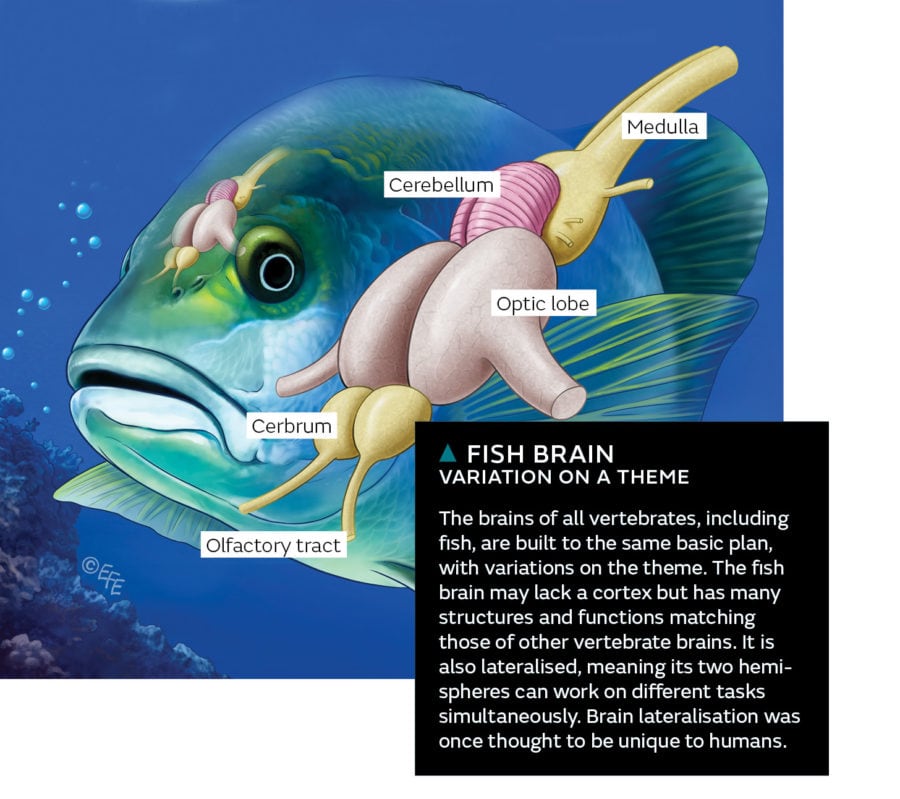
“The hormones are the same; the neurons are the same; brain structure is very similar. People tend to focus on how different we are, but the scientific reality is that we’re actually very, very similar. The idea of higher and lower, primitive and advanced, doesn’t exist in evolutionary terms – we’re just another animal among the diversity. I fundamentally disagree with the idea that humans are the best and that you can only be intelligent if you’re similar to a human.”
Fish may seem dumb to us because their expressionless faces make them look dumb and uncommunicative. But that’s partly because we don’t understand the signals they give out. It takes much watching to become familiar with those signals, as scuba divers and owners of pet fish can testify.
We also seem to be unduly influenced by a perception that small brains must be primitive. On a scientific level, it’s a misconception that because the fish brain lacks a cortex – which in humans is responsible for perceiving, producing and understanding language – it must necessarily be incapable of performing many of the tasks of a human cortex. But Culum argues that the human cortex has taken on a huge number of roles that were once the domain of other brain regions. After all, a small brain and lack of a cortex hasn’t prevented many birds from becoming super-smart. Why should fish be any different?
Then there’s brain lateralisation, a structural adaptation that allows the brain’s two hemispheres to perform different tasks. “It’s like a computer, in which different elements can work on different parts of a problem simultaneously and can collaborate,” Culum explains. “Thirty years ago, we used to think lateralisation was a uniquely human trait. Now it turns out just about every animal has a lateralised brain. Experiments on parrots and different fish show that the more strongly lateralised the brain is, the smarter and better it is at problem-solving.”
To do its job effectively, the brain needs information from the outside world to work on, and this comes from an animal’s sensory organs. How do these stack up in fish? In a word, brilliantly. Their vision is superior to ours – they can see more colours – and the abilities of many species to taste and smell are on par with ours.
As for hearing, fish have two systems: one is based directly on the conventional vertebrate inner ear, the other on the lateral line, a visible line along a fish’s side that collects information about water vibration and pressure from the surrounding environment. Not surprisingly, up to half of all fish species use sound to communicate. Minnows, for example, vocalise at one another when fighting.
Furthermore, like many other terrestrial and marine creatures, some fish can detect the Earth’s magnetic field and use it for navigation. Other fish generate bursts of electricity and use them in a way that’s similar to how bats use echolocation to hunt and navigate.
Fish memory
Because intelligence has evolved independently in many different parts of the animal family tree, it’s likely to be something that is very useful for survival. Culum believes the factors that drive it are both environmental and social. “It’s fundamentally to do with your lifestyle, the problems you need to solve to get by and the environment you live in,” he says. For example, it could be influenced by having to find food in sophisticated environments. But it could also be helpful for processing social complexity. “You need a big brain to keep track of social relationships,” Culum adds.
Fish can spend most of their lives in shoals or schools. They must learn and memorise their shoal’s structure, remember their status within it and be able to recognise kin and familiars. (naturepics_li/Getty)
An aspect of intelligence that has long interested Culum has been the way fish learn and remember. One experiment he did on rainbowfish, a popular aquarium species endemic to Australia and Papua New Guinea, involved a net that moved from one end of a fish tank to the other. The net had a single hole in it; to avoid getting trapped, the fish needed to find the hole quickly.
It took them only five goes to master the test. Furthermore, larger groups did better than smaller ones, suggesting they learn from each other via a process known as social learning. And, even though rainbowfish live for only two years, the test fish still remembered the skill 11 months later.
Social learning and memory are essential for any creature living in a large, complex-social group. Fish can spend most of their lives in shoals or schools. They must learn and memorise their shoal’s structure, remember their status within it and be able to recognise kin and familiars.
Having social learning allows the potential for transferring information between individuals and also between generations, leading to the development of ‘cultural traits’ or ‘traditions’ that can persist over time, Culum says. Regular migration routes are examples. Northern Hemisphere cod have been moving to new spawning grounds in recent years, perhaps because commercial fishing has removed older individuals that remember traditional routes, depleting the species’ cultural knowledge.
Most fish activity involves moving through the environment. Long return journeys demand finely tuned spatial learning and memory that can generate mental maps featuring recognisable features in the environment. Without them fish wouldn’t be able to find their way around.
Fish also display some of the most remarkable examples of cooperation between species in the animal kingdom. One of the best examples involves cleaner wrasse. These fish, typically less than 20cm long, make a meal of parasites and bits of dead skin on the bodies of larger, often predatory, ‘client’ fishes. Cleaners operate at fixed ‘cleaning stations’ on coral outcrops. Clients that gather there are of varying species. A cleaner wrasse can remember and recognise more than 100 individual clients and prioritise them according to residential status, dealing with outsiders first because it knows that locals will stick around but outsiders may seek another station if service isn’t fast enough.
Occasionally a cleaner is tempted to ignore the usual menu items and instead bites off a mouthful of tasty and nutritional mucus from a client. The client may flinch at this and swim off ‘in a huff’ while the cleaner, anxious not to lose a customer, swims after it and placates it with a soothing back rub delivered with its pelvic and pectoral fins, in what Culum describes as a striking example of social intelligence.
Another example of cooperation between species involves groupers and giant moray eels, which team up for hunting expeditions. A grouper seeking a hunting partner will entice a moray out of its cavity with specific ‘come hunt with me’ signals. Then the pair sets off, the eel flushing prey from crevices, while the grouper uses its speed to snap up the meals that they share.
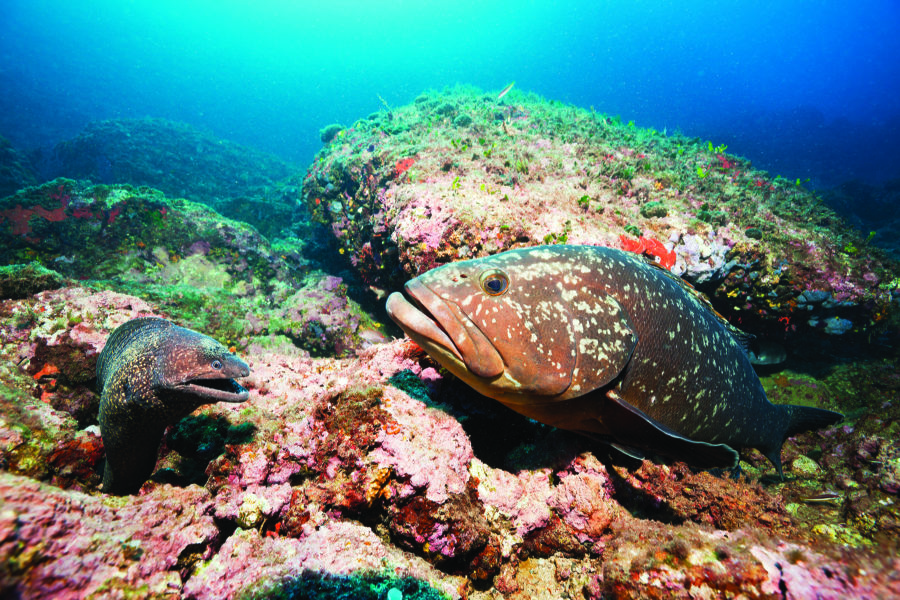
All this involves cognitive complexity on several levels: the deliberate communication between the two to set up the hunt; the different roles they play; and the subsequent sharing of food.
With many scientific studies now pointing to fish being highly intelligent, we face awkward ethical and moral questions about our treatment of them. Remember, they are our among our most numerous food sources and commonly used as pets and laboratory test subjects. Do they suffer and feel pain in these interactions with us? If so, shouldn’t we try to minimise their suffering by granting them the same animal welfare rights we grant other creatures such as livestock, dogs and cats?
In a 2015 paper in the journal Animal Cognition, Culum argued that there is no doubt fish have the ability to perceive pain.
“It would be impossible for fish to survive as cognitively and behaviourally complex animals without a capacity to feel pain,” he wrote. “Feeling pain and responding appropriately…are clearly critical to survival.”
The incredible collective behaviour of fish
PROFESSOR ASHLEY WARD is an animal behaviourist at the University of Sydney. He studies group-living in animals, mostly the collective behaviour of fish. While growing up in the UK, he, too, had an inspiring childhood encounter with fish. It happened after he’d been given a face mask for snorkelling.
“I jumped into a river not far from where I lived and saw this incredible shoal of minnows,” Ashley tells me. “There were hundreds and it was mind-blowing, the way they moved together and performed these orchestrated, coordinated movements. It was the most fantastic thing I’d ever seen.”
As we chat in his office, we’re joined at the window by a noisy miner bird that feeds from a plastic container. Its name is Ken, Ashley says, and it’s a regular visitor.
Through their fish studies, Ashley and his team have developed a mathematical tool kit that helps reveal how individual fish interact with those around them, and how the group shapes individuals.
“The collective behaviour of fish is mathematically very similar to the collective behaviour of certainly birds, certainly krill, certainly sheep, and perhaps humans too,” he says.
Collective decision-making within a group – for instance, about the direction a shoal should turn – is something else Ashley has studied. He’s found that the bigger the group, the faster and better its decision-making.
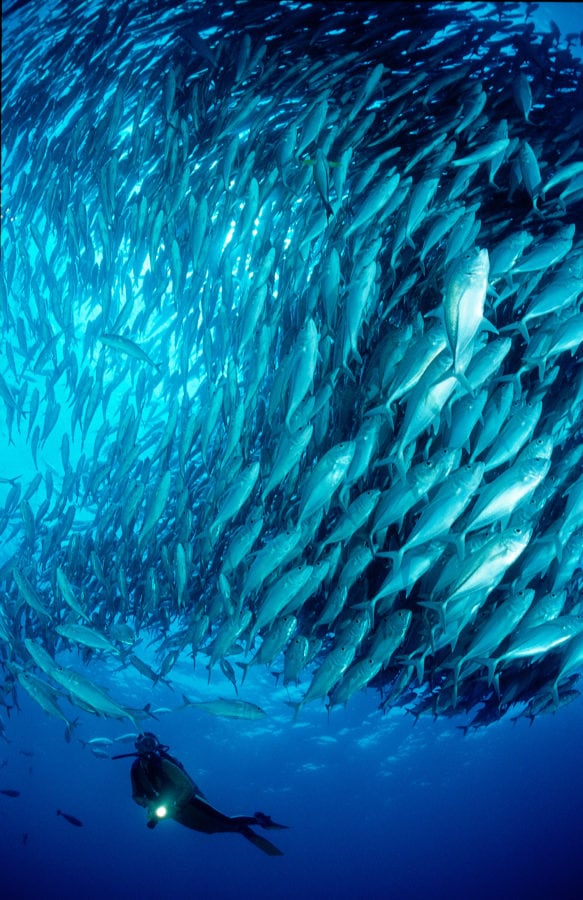
“I’ve attended endless tedious academic meetings, and inevitably the larger the meeting, the longer it takes to get resolution. If group-living animals were paralysed by increasing group size, group-living simply wouldn’t work,” he says.
Ashley has found the same phenomenon across a range of fish. Collecting, integrating and acting on information doesn’t require each individual to have its own say or to object. The process is achieved in a smooth, non-vocal way and the result is dramatic to watch.
“Where that talks to fish intelligence is in the ability of each individual in the group to act as a part of the whole, to integrate into the group, perform a function and rely on others to perform other functions, but still do it effectively,” Ashley explains.
He has no doubt fish are intelligent and capable of highly sophisticated behaviour, but he keeps an open mind on whether they feel pain or suffer in the sense we understand. Even so, he’s in favour of an animal welfare approach, especially with commercial fishing, laboratory animals and pets. He adds that there can be few things worse for a shoaling fish than being alone in a small, featureless container: “If you put a single herring in a tub, it dies of loneliness, of the sheer stress of the situation.”
Do fish feel pain?
PROFESSOR BRIAN KEY heads the Brain Growth and Regeneration lab at The University of Queensland. He works on fish, frogs and mice and doesn’t mince words on the subject of fish pain. In a paper entitled “Why fish do not feel pain” published in 2016 in the journal Animal Sentience, he lays out the evidence that they lack the neural hardware, specifically a cortex, to experience it.
A fish can’t tell you if it’s feeling pain, Brian argues. We can only watch how it behaves and make an interpretation based on that.
“Once you try to take that beyond behavioural analysis, it’s all guesswork,” he says. “You’re making assumptions without looking at the neural basis. It’s premature to jump to conclusions about issues such as pain in fish. Science is trying to understand the neural basis of it, but we’re not there yet.”
On the question of animal welfare, Brian emphasises it needn’t be linked specifically to an animal’s ability to feel pain. “You can apply human principles to animal welfare,” he says. “Those principles don’t have to be based on scientific evidence; they can be based on the morals and ethics of a society.”
Culum is one of many scientists who disagree with Brian’s stance on whether fish feel pain. He says it’s a human-centred argument based on the idea that fish don’t share the structures that humans have for feeling pain. He points out that many studies show that fish have the neurons to detect pain, and their behaviour changes in ways you’d expect see when they’re feeling pain.
“If you feel pain and don’t respond in an appropriate way, you’re almost certainly going to die,” he says. “The reason all animals feel and respond to pain is purely survival, which explains why it’s so ancient. To argue that fish don’t have this capacity on the basis of some predetermined belief that they’re primitive is nonsensical.”
Nevertheless, Culum does come close to agreeing with Brian on animal welfare, previously writing that “it behoves us as human beings to treat all animals with respect and to minimise pain and suffering where we are able to do so”.
It’s been a long road since those pet fish first inspired Culum. And it’s now come full circle: his nine-year-old daughter, Maia, recently had the same kind of aha moment that he once had in front of his fish tank as a small boy.
“I’ve got her feeding the fish every day at home, and just a week ago she said exactly what I’d said: ‘Look, they only respond to me, not to anybody else.’ So she’s having the same kind of realisations that I did, at almost the same age.”
This article was originally published in Issue 154 of Australian Geographic.
